Ferrexpo’s Poltava Mining subsidiary has been on a journey to both stimulate demand for iron ore pellets and increase the Fe content of its product. The crushing and flotation technology of Metso has played a key role in this evolution, according to Alexey Strikha*.
In 1960, the exploration of Kremenchug magnetic anomaly started on the left bank of the Dnieper River, Ukraine. At that time, the foundation of the future Poltava Mining refinery was laid, and, 10 years later, the plant produced its first batch of concentrate.
There were several phases of plant construction: in 1980, after launching the pelletising plant, the company presented a new type of product to the market – iron ore pellets. To stimulate the demand for this product, the company needed to improve the product’s quality, ie increase the iron content in the concentrate.
Keeping this in mind, the company’s managers decided to upgrade the ore pre-treatment operations: reduce the fragmentation size to cut the costs of further ore degradation. Due to space constraints at the crushing plant, the company was in need of new equipment with the exact dimensions of the current foundation structures. At that time, Svedala (acquired by Metso in 2001) engineers suggested testing the Barmac vertical shaft impact crusher.
“The conventional crusher-based closed cycle of check screening was not an option for us, so we were offered inertial crushers for coarse lumps. And this proved to be a good technical solution,” said Vladimir Khovanets, Chief Concentrating Engineer at Poltava Mining.
Alexander Lysenko, Poltava Mining’s Chief Technical Officer said: “Metso always does lots of research and testing to offer us an integrated solution, i.e. technology that gives us exactly what we want.”
After the pilot testing, the middle and small fraction crusher lines were upgraded with Barmac crushers. That project was a success, so both companies decided to expand further joint activities: two double-drum separators were installed instead of eight locally manufactured triple-drum separators with no loss in productivity.
Flotation technology
These earlier projects to upgrade the crushing and magnetic concentration processes laid the foundation for further improvement in the concentrate quality.
Lysenko said: “It’s common knowledge that our ore is quite lean, and the market was in demand of high-quality iron ore pellets containing 62-65% Fe.”
Two methods are used for concentration of lean ores: magnetic and flotation concentration. During the engineering study of these methods, Metso installed a pilot plant with laboratory mills, flotation cells, magnetic separators and hydrocyclones.
Igor Grebeniuk, Regional Sales Manager at Metso, said: “The pilot results proved that 67-68% Fe content in the pellets manufactured from Poltava Mining ores was quite possible after the flotation upgrading.”
In 2002, the company launched Flotation Plant 1 equipped with Metso RCS130. It was the first project in the former Soviet Union to use flotation upgrading in the ferrous industry. Keeping this in mind, the engineers at Poltava Mining ran a detailed preliminary analysis of the new technology, studying the cases of Metso equipment supplied to the concentration plants in the USA and Canada.
Lysenko said: “Metso explained all the benefits and the hidden risks. And we saw that the technology works. It’s friendly to the environment and commercially feasible.”
Reducing grain size
Commissioning of the new flotation plant entailed the modification of the crushing lines, since super-fine grain is required for efficient magnetic upgrading of concentrate.
Khovanets recalled: “While working with Flotation Plant 1, we gained the insight that Flotation Plants 2 and 3 need to be constructed for the strategic development of the company. And conventional drum mills were not so good for that process.”
Lysenko said: “Thanks to flotation, we were able to increase the yield of iron from quite lean ores, but we couldn’t get enough homogeneous product using the conventional crushing line.”
Metso engineers suggested Vertimill for high-quality and fine milling of the product. In coordination with Ferrexpo engineers, a concentration line with vertical mills for all flotation cells was developed.
Khovanets said: “After magnetic concentration, we get about 85-89% of below 44 microns grade. Vertimill machines help to bring up the fineness of grinding, ie up to 90% of ground materials are minus 33 microns.
“Vertimill machines offer a new design. A conventional drum mill operates in the horizontal position, while Vertimill is installed vertically. The space needed of such equipment is much smaller, and it provides proper crushing grade.”
Boosting pellet iron content
Two additional flotation cells were commissioned in 2014. These additional cells gave a step change in the concentration technology. Today, ore from different fields is processed separately at Flotation Plants 1 and 2, while Flotation Plant 3 is used for iron recovery from froth.
Lysenko said: “Before commissioning the plant, we produced pellets with 62% Fe content. Due to flotation upgrading we now have 67% concentrate, and this brings the product’s quality to a new level. I mean pellets with 65% Fe content.”
Introduction of the new iron ore concentration technologies entails upgrading the next downstream process, namely filtration. After the equipment upgrade, it will be possible to reach the maximum dehumidification of concentrate to gain additional quality.
Grebeniuk said about the current projects: “But we go the extra mile. To increase production, we’re now constructing two additional plants, a crushing plant and filtration plant.”
A tough market requires high-grade product rich in iron and with minimum impurities. After the process upgrade, Poltava Mining was able to improve the pellet quality, which also means more investments in the infrastructure of its hometown.
Ruslan Klimenko, Chief Communication Officer of Poltava Mining, said: “We want to offer benefits to as many people in the city as possible.”
*This story was written by Alexey Strikha, one of Metso’s Regional Directors











